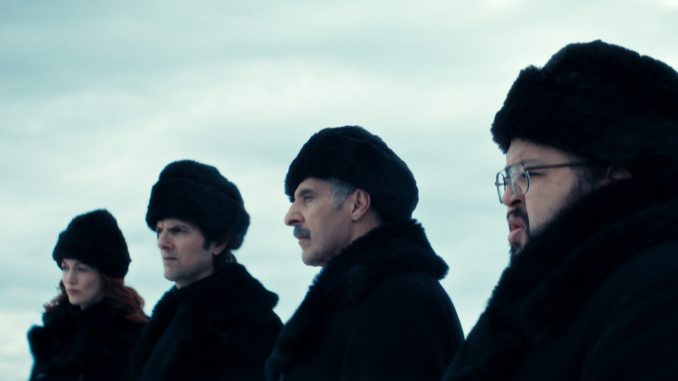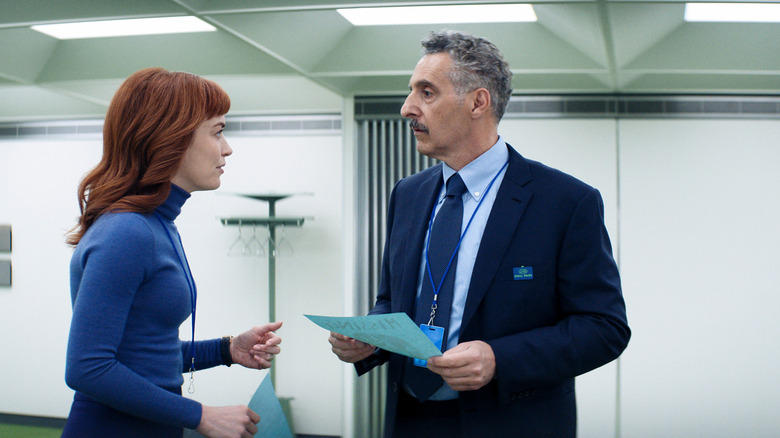
This article contains spoilers for “Severance” season 2 episode 4, “Woe’s Hollow.”
Lumon Industries is up to no good, right? “Severance” loves playing the corporation’s mysteries close to the chest, only revealing the very tip of the horrific iceberg when it absolutely must. However, what the Apple TV+ mystery show has revealed of the company’s true purpose so far is nothing short of chilling, and “Woe’s Hollow” doesn’t exactly ease the viewer’s spirit.
The episode expands the show’s mythology in a number of creepy and characteristically veiled ways, some of which are seen through the eyes of an increasingly unbalanced Irving (John Turturro). After effectively severing ties with the rest of the Macrodata Refinement team during their outdoors team-building retreat, the formerly reliable office drone wanders into the woods to give Mr. Milchick (Tramell Tillman) a piece of his mind. Unfortunately, Irving loses his way and is forced to sleep rough in the dark forest.
Here, he experiences a dream vision that’s right up there with the most unnerving sights “Severance” has featured so far. It shows a haggard-looking personification of Woe — one of the series’ Eagan-mandated “four humors” — working on the Macrodata Refinement work station in the middle of the forest. When Irving investigates closer, he sees a screen with numbers that dance and form eerie patterns that resemble an eye. Small text up top reads: “Montauk 3% complete.” The dream ends with a predictable but effective jump scare by the Woe lady, but the aforementioned text reveal is the real wallop.
Let’s take a look at the Montauk Project, and what this old conspiracy theory might mean for the poor innie characters of “Severance.”
Montauk is the show’s clearest conspiracy theory reference yet
The most likely culprit behind “Severance’s” Montauk reference is already familiar to dedicated fans of Netflix’s “Stranger Things.” The Duffer Brothers’ sci-fi adventure show was inspired by a creepy, supposedly real experiment called the Montauk Project, to the point that the series’ working title was “Montauk.” The word refers to an alleged top secret U.S. military project that took place at either the Montauk Air Force Station or Camp Hero on Long Island, New York. The Montauk Project supposedly involved the greatest hits of government-related conspiracy theories, from time travel and mind control research to teleportation and aliens.
The theory of the Montauk Project’s assorted shady antics bears significant similarities to the Philadelphia Experiment, a 1940s U.S. Navy conspiracy theory that itself inspired “The X-Files” season 2 episode “Død Kalm.” This alleged time travel incident was also the subject of the 1984 sci-fi thriller “The Philadelphia Experiment,” among many other pop culture allusions.
Knowing Montauk’s history, the way “Woe’s Hollow” drops the name in one of the episode’s most pivotal scenes is unlikely to be coincidental. Montauk carries plenty of weight in pop culture — in the collaborative fiction project “SCP Foundation,” for instance, it lends its name to a terrifying but unspecified procedure that’s used to contain an entity known as SCP-231. Seeing the word on “Severance” and knowing its history adds no small amount of weight to the possibility that Lumon’s severed floor is actually a major experiment of the psy-ops or even paranormal variety.
Severance is fond of creating its own versions of real events and concepts
Apart from the strange rules and cult-like fervor that the company imposes on its severed personnel, every Lumon department on the severed floor seems to be up to something shady, from the absurd rural antics of Mammalians Nurturable to the fact that Mark’s (Adam Scott) seemingly dead wife Gemma (Dichen Lachman) is still alive and has an innie called Ms. Casey. The show has also teased the importance of Cold Harbor, an important macrodata file that hinges on Mark’s work and seems to be connected to Gemma. The regularly reemerging focus on Kier Eagan’s Four Tempers — woe, frolic, dread, and malice — also seems to be connected to the Macrodata Refinement’s job of sorting out numbers based on the emotions they elicit.
It’s worth noting that many of the show’s more ominous concepts have real-world significance. “Cold Harbor” may be a reference to a Civil War battle that took place in 1964, a year before Lumon Industries was founded. The Four Tempers philosophy is essentially a Kier Eagan twist on Hippocrates’ ancient psychological concept of Four Temperaments, which itself derives from an even older medical theory of Four Humors.
Since these “Severance” concepts have enough connection to the real world to make the viewer wonder, the dream referencing Montauk in “Woe’s Hollow” is unnerving. Perhaps it simply refers to a file that’s Irving’s version of whatever Cold Harbor represents to Mark. Maybe this Montauk ties into the ending of “Severance” season 1, which implies that Lumon is planning something severance-related on a global scale … or it could be something even worse. Whatever it is, viewers should probably be happy that the Montauk process in Irving’s almost certainly prophetic dream is currently only 3% completed.




Leave a Reply